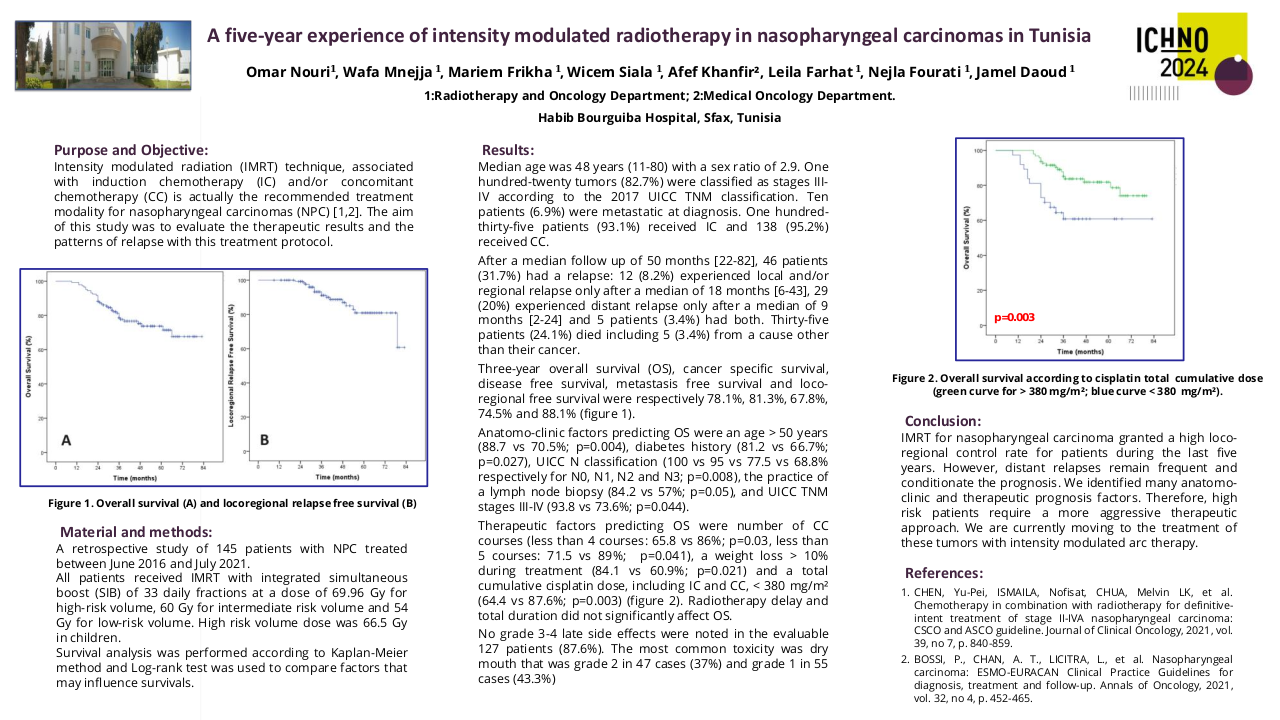Prognostic and Survival analysis of patients with locally advanced nasopharyngeal carcinoma with optic pathways involvement.
Purpose/Objective
To evaluate the prognostic and Survival of patients with locally advanced nasopharyngeal carcinoma with opticpathways involvement, treated by intensity-modulated radiotherapy (IMRT) and concomitant Cisplatin, with or without induction chemotherapy.
Material/Methods
We retrospectively reviewed data for 40 consecutive patients treated by IMRT in the radiotherapy departement of Salah azeiez hospital in Tunisia, between 2014 and 2018.
Results
The mean patient age at diagnosis was 42,65 years (19-81) and the sex ratio was 1,85. All patients had undifferentiated carcinoma of the nasopharynx (UCNT) and were staged T4 according to the seventh edition of the American Joint Committee on Cancer (AJCC) staging system. Patients presented a variety of ocular symptoms, along with other signs such as; diplopia (28,2%), proptosis (10,3%), exophtalmie (5,1%) and oculomotor nerve pulsy (5,1%).Symptomatic orbital invasion by tumor occurred in 19 of the 40 patients (48,7%). Ocular signs, but no orbital invasion, was present in 13 patients (32,5%). The CT scan showed orbital involvement in 21 cases (52,5%), sphenoidal involvement in 32 cases (80%), ethmoidal involvement in 22 cases (55%) and skull base invasion in 38 cases (95%). Neoadjuvant chemotherapy was adminisered to 22 patients (55%). All patients underwent concomitant cisplatin based chemoradiotherapy.
The median follow-up was 48,5 months (24 to 83 months), 20 patients (50%) died and 20 (50%) were still alive. A total of 18 (45%) patients experienced failures (30%) and distant metastases (25%). Locoregional failures were seen in 12 (30%) patients. 10 patients (25%) experienced local failure and 2 (5%) patients experienced a nodal failure. Three patients (7,5%) presented unilateral blindness which might be resulted from radiation-induced optic neuropathy. At last follow-up, 19 out of 40 patients (47,5%) were alive without any disease
The mean overall survival (OS) was 40,22 months (HR=4,161, 95%CI 32,070-48,382). The 5-year rate of OS was 47,4%. The mean disease free survival (DFS) was 37,740 months (HR=4,754, 95%CI 28,421-47,058). The 5-year rate of DFS was 49 %.
The univariate analysis revealed that orbital involvement did significantly affect overall survival (P=0,000). Orbital involvement was also identified as an independent prognostic factor for OS (hazard ratio 0,159; 95 % CI 0.043–0.588; P = 0.006). However, Tumor volume higher than 100 cm3 (hazard ratio=0,130 ; 95 % CI 0,022 – 0,771; P = 0,025) and dose at CTVp1 lower than 66 Gy (hazard ratio=0,137 ; 95 % CI 0,028–0,665; P = 0,014) were identified as an independent prognostic factors for DFS.
Conclusion
T4 non metastatic locally advanced NPC with optic pathways involvement is uncommon and it confers a particular bad prognosis. Indeed, the IMRT modality provides adequate local-regional control for T4 NPC. However, even with the most sophisticated treatment techniques, the clinical outcome remains low for this subgroup.
1. Wided BAH, Hamouda B, Hamadi H, Mansour BA. Nasopharyngeal Carcinoma Incidence in North Tunisia: Negative Trends in Adults but not Adolescents, 1994-2006. Asian Pacific Journal of Cancer Prevention. 14 avr 2015;16(7):2653‑7. 2. Frikha M, Bouaziz M, Daoud J, Ghorbel A, Elloumi M, Boudaya M, et al. [Evaluation of tumoral and lymph node response to neoadjuvant chemotherapy in undifferentiated nasopharyngeal carcinoma]. Bull Cancer. mars 1997;84(3):273‑6. 3. Wong WM, Young SM, Amrith S. Ophthalmic involvement in nasopharyngeal carcinoma. Orbit. 4 mars 2017;36(2):84‑90. 4. Hsu W-M, Wang A-G. Nasopharyngeal carcinoma with orbital invasion. Eye. août 2004;18(8):833‑8. 5. Cao C, Jiang F, Jin Q, Jin T, Huang S, Hu Q, et al. Locoregional extension and patterns of failure for nasopharyngeal carcinoma with intracranial extension. Oral Oncology. avr 2018;79:27‑32.






